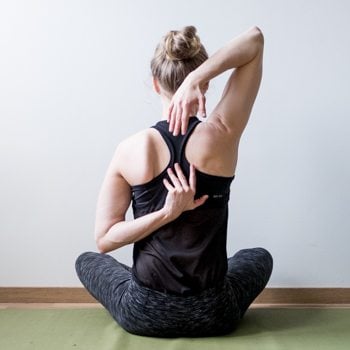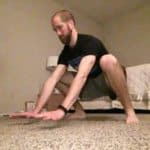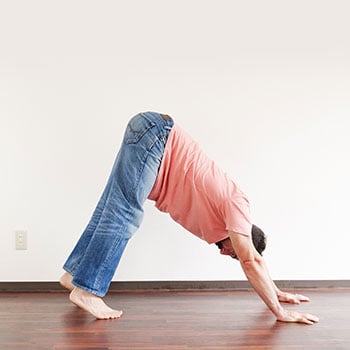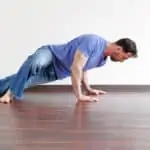Modern life, with years of sitting, repetitive movements, and old injuries have a way of locking our shoulders up. Reaching overhead feels tight. Your upper back stays tense. And no amount of random stretching seems to fix it.
 The good news? You don’t need a whole new lifestyle or hour-long routines.
The good news? You don’t need a whole new lifestyle or hour-long routines.
Just a few minutes a day of focused shoulder mobility work can help you move better, feel stronger, and shake off that nagging tension.
This guide gives you exactly that.
A simple, effective routine designed by rehab pros and movement nerds—so you can get back to doing what you love (without feeling like your shoulders are made of cement).
We want you to take just a few minutes out your day to help you move, feel, and perform better.
8 Shoulder Mobility Exercises for Pain-Free Movement
1. Full Body Vibrations
✅ Releases tension and prepares you for the routine
Let your whole body shake out. Seriously—just bounce a bit. This isn’t fluff; it’s a fast, effective way to release built-up tension and prep your nervous system for better movement. Think of it as hitting the reset button before the real work begins.
2. A-Frame to Bear
✅ Combines opening your shoulders and active whole body movement
This is more than a stretch—it’s a whole-body flow. You’ll move from an A-frame (like a Downward Dog pose) into a Bear position, opening up your shoulders while activating your hips and core. Controlled, dynamic, and a great way to get everything moving well with each other.
3. Quadruped Shoulder Circles
✅ Improves scapular control and full shoulder movement
These circles train full scapular control—front, back, up, and down. A lot of shoulder stiffness is tied to poor scapular movement. This drill teaches your shoulder blades to glide properly, helping you move more freely in every direction.
4. Prone Bent Arm Chest Stretch
✅ Opens up the chest and front of the shoulders
Lie face down, bend one arm like a goalpost, and gently toward that side to open up. This hits the front of the shoulder and chest—where a lot of desk-bound tension lives. Go slow, breathe out and settle gently into the position.
5. Clasped Hands Extension
✅ Counters slumped posture and improves shoulder extension
Interlace your fingers behind you, extend your arms, and lift. Simple—but sneaky effective. This counters the “slouch and shrug” posture most of us live in, restoring shoulder extension and getting the upper back muscles and the backs of your shoulders to wake up.
6. Three Point Bridge
✅ Strengthens shoulders while opening up your upper back
A classic from our library. You’ll drive through your hand, feet, and hips to lift into a bridge with one arm. It’s full-body, but the real magic happens in your shoulders and spine. This builds strength and mobility at the same time.
7. Lounge Chair
✅ Fully opening your chest and shoulders
Yes, it kind of looks like you’re lounging. But you’re actively working to open the shoulders and chest while sitting into deep flexion. It’s a big posture opener that feels restorative—but demands control and attention.
8. Pulling Prep
✅ Strengthens your deep shoulder girdle muscles and targets the lats
This one trains the smaller, deeper muscles of your shoulder girdle—especially the lower traps and lats. It helps with pulling strength, posture, and that feeling of being “set” before lifting or hanging.
When tight shoulders are holding you back the most important thing to do is to address that problem! That’s what these exercises will help with.
But you might also wonder why your shoulders are so tight in the first place. So let’s take a look at that…
Why Are Your Shoulders Tight?

For many, it’s a prolonged desk posture—hunched over a computer for hours. For others, it’s an unbalanced training routine—too much pressing without enough pulling. Tight shoulders usually don’t come from one big problem—they come from years of little ones adding up.
Hours at a desk. Too much pressing, not enough pulling. Old injuries. Not enough movement in all directions.
Your shoulders are a complex system—over 16 muscles working together. When one part’s off, everything else compensates. That’s why shoulder tightness often comes with neck tension, upper back pain, and even cranky elbows.
The routine we shared hits the big issues: tight chest, restricted rotation, weak scapular control. And it doesn’t just isolate them—it connects them into real, usable movement. It’s a glimpse of how we approach all of our training at GMB Fitness.
Not just piece by piece, but a fully integrated movement solution.
Build Shoulder Mobility That Actually Lasts
These drills will help you feel better. But real, long-term shoulder mobility doesn’t come from chasing individual stretches.
It comes from moving your whole body well—and often.
That’s why Elements isn’t a “shoulder program.” It’s a full-body movement system built around foundational patterns that naturally unlock your shoulders, upper back, and everything connected to them.
You’ll train locomotion movements such as:
Bear – Which challenges and builds scapular control while gently opening your upper back and lats.
Monkey – Which loads your shoulders in lateral and rotational patterns most people never touch.
Frogger – Which combines your core and shoulder coordination in a way that improves both overhead and pushing positions.
These movements don’t just stretch or activate individual muscles. They train your body to coordinate movement across multiple joints—just like you actually use them in real life.
So instead of treating tight shoulders like a single issue to “fix,” Elements makes your shoulders stronger, freer, and more integrated into how you move every day.
Your Shoulders Work Best When They’re Not Working Alone
Shoulder-specific exercises can help at first, but integrating your shoulders into full-body movement is key. Elements takes the principles of shoulder stability and applies them in a whole-body context.
The Gradual Track in Elements provides a gentler introduction which is ideal for sensitive shoulders needing reduced time on your hands and shorter sessions.

I was a bit worried that I wouldn't be able to complete many of the movements in Elements because I'm rehabbing from a shoulder surgery.
I couldn't have been more wrong!
I've been able to move at my own pace, and ease into the movements a little bit at a time. Working through Elements has helped me develop stability and range of motion with my shoulder that I never thought I'd regain. That confidence is invaluable. When I look back at my first videos compared to where I am now, I can't believe how far I've come.
Another thing I love about Elements is that even though I just wrapped up my second round of Elements and am about to kick off my third, it doesn't get old. I see the way the coaches move in the videos and know that I have SO much more that I can accomplish, and that really excites me.





